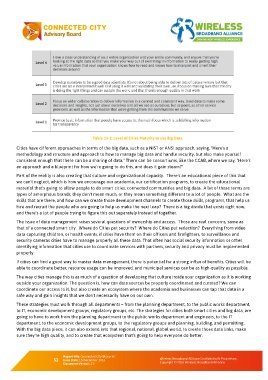Page 54 - Microsoft Word - Connected City Blueprint - V1 (JPEG TABLES).docx
P. 54
Table 10-1: Level of Cities Maturity to use Big Data
Cities have different approaches in terms of the big data, such as a NIST or ANSI approach, saying, "Here's a
methodology and structure and approach to how to manage big data and handle security, but also make yourself
consistent enough that there can be a sharing of data." There can be consortiums, like the CCAB, where we say, "Here's
an approach and a blueprint for how we're going to do this, and does it gain steam?"
Part of the reality is also creating that culture and organizational capacity. There's an educational piece of this that
we can't neglect, which is how we encourage our academia, our certification programs, to create the educational
material that's going to allow people to do smart cities, connected communities and big data. A lot of these terms are
types of amorphous brands; they don't mean much, or they mean something different to a lot of people. What are the
skills that are there, and how can we create those development channels to create those skills, programs, that help us
hire and recruit the people who are going to help us make the next leap? There is a big divide that exists right now,
and there’s a lot of people trying to figure this out separately instead of together.
The issue of data management raises several questions of ownership and access. Those are real concerns, same as
that of a connected smart city. Where do Cities put security? Where do Cities put redaction? Everything from video
data capturing children, or health events, if cities have them on their officers and firefighters, to surveillance and
security cameras cities have to manage properly all these data. That often has social security information or other
identifying information that cities use to coordinate services with partners, security and privacy must be implemented
properly.
If cities can find a good way to master data management, there is potential for a strong influx of benefits. Cities will be
able to coordinate better, resource usage can be improved, and municipal services can be as high-quality as possible.
The way cities manage this is as much of a question of developing that culture inside your organization as it is working
outside your organization. The question is, how can data sources be properly coordinated and curated? We can
coordinate our access to it, but also create an ecosystem where the academia and businesses can tap that data in a
safe way and gain insights that we don't necessarily have on our own.
These strategies must work through all departments – from the planning department, to the public works department,
to IT, economic development groups, regulatory groups, etc. The strategies for cities both smart cities and big data, are
going to have to work from the planning department to the public works department and engineers, to the IT
department, to the economic development groups, to the regulatory groups and planning, building, and permitting.
With the big data piece, it can also extend into that regional, national, global world, to create those data links, make
sure they're high quality, and to create that ecosystem that's going to help everyone do better.
Report title: Connected City Blueprint
51 Issue Date: 15 December 2016 Wireless Broadband Alliance Confidential & Proprietary.
Copyright © 2016 Wireless Broadband Alliance
Document Version: 1.0

